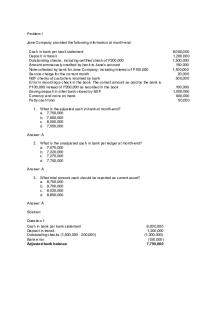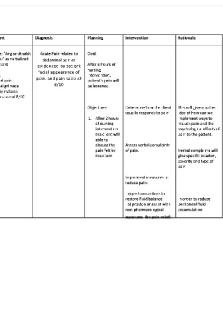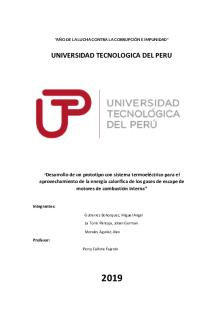Theory respectively compress PDF

| Title | Theory respectively compress |
|---|---|
| Course | Drawing |
| Institution | CECOS University of IT and Emerging Sciences |
| Pages | 7 |
| File Size | 132.1 KB |
| File Type | |
| Total Downloads | 111 |
| Total Views | 161 |
Summary
sdf sdf asdf asdfsd fsdfsdfsdfsdf sdf asdf asdfasf dfasdf wer asdfaa...
Description
Dividend Policy Multiple Choice Questions 1.
The residual theory of dividends suggests that dividends are _________ to the value of the firm. (a) residual (b) relevant (c) irrelevant (d) integral Answer: C
2.
The information content of dividends refers to (a) nonpayment of dividends by corporations. (b) dividend changes as indicators of a firm’s future. (c) a stable and continuous dividend. (d) a dividend paid as a percent of current earnings. Answer: B
3.
According to the residual theory of dividends, if the firm’s equity need exceeds the amount of retained earnings, the firm would (a) borrow to pay the cash dividend. (b) sell additional stock to pay the cash dividend. (c) pay no cash dividends. (d) not need to consider its dividend policy. Answer: C
4.
According to the residual theory of dividends, if the firm’s equity need is less than the amount of retained earnings, the firm would (a) borrow to pay the cash dividend. (b) declare a dividend equal to the remaining balance. (c) pay no cash dividends. (d) not need to consider its dividend policy. Answer: B
5.
The clientele effect refers to (a) the relevance of dividend policy on share value. (b) the firm’s ability to attract stockholders whose dividend preferences are similar to the firm’s dividend policy. (c) the informational content of dividends. (d) the “bird-in-the-hand” argument. Answer: B
6.
Modigliani and Miller suggest that the value of the firm is not affected by the firm’s dividend policy, due to (a) the relevance of dividends. (b) the clientele effect. (c) the informational content.
(d) the optimal capital structure. Answer: B 7.
Modigliani and Miller, recognizing that dividends do somehow affect stock prices, suggest that positive effects of dividend increases are attributable (a) directly to the dividend policy. (b) directly to the optimal capital structure. (c) not to the informational content but to the consistency in the payment of dividends. (d) not to the dividend itself but to the informational content of the dividends with respect to future earnings. Answer: D
8.
Modigliani and Miller argue that when the firm has no acceptable investment opportunities, it should (a) close its doors. (b) distribute the unneeded funds to the owners. (c) lower its cost of capital. (d) retain the funds until an acceptable project arises. Answer: B
9.
Gordon’s “bird-in-the-hand” argument suggests that (a) dividends are irrelevant. (b) firms should have a 100 percent payout policy. (c) shareholders are generally risk averse and attach less risk to current dividends. (d) the market value of the firm is unaffected by dividend policy. Answer: C
10.
Proponents of the dividend irrelevance theory argue that, all else being equal, an investor’s required return and the value of the firm are unaffected by dividend policy, for all of the following reasons, EXCEPT (a) the firm’s value is determined solely by the earning power and risk of its assets. (b) investor’s are generally risk averse and attach less risk to current as opposed to future dividends or capital gains. (c) if dividends do affect value, they do so solely because of their information content, which signals managements’ earnings expectations. (d) a clientele effect exists which causes a firm’s shareholders to receive the dividends that they expect. Answer: B
11.
The factors involved in setting a dividend policy include all of the following EXCEPT (a) restrictive covenants in a bond indenture. (b) growth prospects. (c) the legal prohibition on paying dividends which exceed current earnings. (d) capital impairment restrictions. Answer: C
12.
The dividend policy must be formulated considering two basic objectives, namely
(a) delaying the tax liability of the stockholder and information content. (b) maximizing shareholder wealth and delaying the tax liability of the stockholder. (c) maximizing shareholder wealth and providing for sufficient financing. (d) maintaining liquidity and minimizing the weighted average cost of capital. Answer: C 13.
The problem with a constant-payout-ratio dividend policy from the shareholder’s perspective is that (a) it bores the shareholders. (b) if the firm’s earnings drop, so does the dividend payment. (c) even when earnings are low, the company must pay a fixed dividend. (d) there is no informational content. Answer: B
14.
The problem with the regular dividend policy from the firm’s perspective is that (a) it bores the shareholders. (b) if the firm’s earnings drop, so does the dividend payment. (c) even when earnings are low, the company must pay a fixed dividend. (d) it increases the shareholders’ uncertainty. Answer: C
15.
The advantage of using the low-regular-and-extra dividend policy is that (a) the firm avoids giving the shareholders false hopes. (b) if the firm’s earnings drop, so does the dividend payment. (c) the extra dividend may become a regular event. (d) cyclical shifts in earnings may be avoided. Answer: A
16.
A firm has had the following earnings history over the last five years: Year 2003 2002 2001 2000 1999
Earnings per Share $2.50 2.00 1.75 1.25 –1.00
If the firm’s dividend policy is based on a $0.50 payout per share, increasing by $0.25 per share whenever earnings exceed $1.50 per share, the annual dividends for 1999 and 2002 were (a) $0.00 and $2.00, respectively. (b) $0.50 and $0.75, respectively. (c) $0 and $0.75, respectively. (d) $0.50 and $0.55, respectively. Answer: C 17.
A firm has had the following earnings history over the last five years: Year
Earnings per Share
2003 2002 2001 2000 1999
$2.50 2.00 1.75 1.25 –1.00
If the firm’s dividend policy was based on a constant payout ratio of 50 percent for all of the years with earnings over $1.50 per share and a zero payout otherwise, the annual dividends for 1999 and 2002 were (a) $0.50 and $1.25, respectively. (b) $0 and $2.00, respectively. (c) $0 and $1.25, respectively. (d) $0 and $1.00, respectively. Answer: D 18.
A firm has had the following earnings history over the last five years: Year 2003 2002 2001 2000 1999
Earnings per Share $2.50 2.00 1.75 1.25 –1.00
If the firm’s dividend policy was to pay $0.25 per share each period except when earnings exceed $1.50, when an extra dividend equal to 50 percent of the earnings above $1.50 would be paid, the annual dividends for 2000 and 2002 were (a) $0.25 and $1.25, respectively. (b) $0.25 and $0.75, respectively. (c) $0 and $0.25, respectively. (d) $0.25 and $0.50, respectively. Answer: D 19.
The shareholder receiving a stock dividend receives (a) a share of common stock of equal value to their existing shares of common stock. (b) cash. (c) additional shares of common stock and cash. (d) nothing of value. Answer: D
20.
The purpose of a stock split is to (a) affect the firm’s capital structure. (b) decrease the dividend. (c) enhance the trading activity of the stock by lowering the market price. (d) increase the market price of the stock. Answer: C
21.
A stock split has _________ effect on the firm’s capital structure.
(a) little (b) no (c) a measurable (d) a detrimental Answer: B 22.
The purpose of a reverse stock split is to (a) issue additional shares. (b) increase the dividend. (c) increase the price of stock. (d) reduce trading activity. Answer: C
23.
Stock repurchases are made for all of the following reasons EXCEPT (a) to obtain shares to be used in acquisition. (b) to retire outstanding issues. (c) to have shares available for stock option plans. (d) to decrease the book value of equity. Answer: D
24.
When common stock is repurchased and retired, the underlying motive is to (a) delay taxes. (b) boost the stock’s dividends. (c) distribute the excess cash to the owners. (d) reduce the retained earnings balance. Answer: C
25.
The repurchase of stock _________ the earnings per share and _________ the market price of stock. (a) increases; increases (b) decreases; decreases (c) increases; decreases (d) decreases; increases Answer: A
26.
Stock repurchases may be made for all of the following reasons EXCEPT (a) to enhance shareholder value by reducing the number of shares outstanding and thereby raising earnings per share. (b) to help discourage an unfriendly takeover by reducing the number of publicly traded shares. (c) to make shares available for stock option plans. (d) to make shares available for stock dividends. Answer: D
27.
When purchasing outstanding shares of common stock a firm can utilize all of the following methods EXCEPT (a) purchase on the open market at market prices. (b) with a tender offer at varying prices. (c) with a tender offer at a specified price. (d) by purchasing a large block on a negotiated basis.
Answer: B 28.
The net effect of a stock repurchase is (a) similar to the payment of a stock dividend. (b) similar to a cash dividend. (c) similar to a stock split. (d) similar to a reverse stock split. Answer: B
29.
Enhancement of shareholder value through stock repurchase is achieved by (a) reducing the number of shares outstanding and thereby raising earnings per share. (b) sending a positive signal to investors in the marketplace that management believes that the stock is undervalued. (c) providing a temporary floor for the stock price, which may have been declining. (d) all of the above. Answer: D
30.
At the quarterly meeting of Tangshan Mining Corporation, held on September 10th, the directors declared a $1.00 per share dividend for the firm’s 100,000 shares of common stock outstanding. The net effect of declaring and paying this dividend would be to (a) decrease total assets by $100,000 and increase stockholders equity by $100,000. (b) decrease total assets by $100,000 and decrease stockholders equity by $100,000. (c) increase total assets by $100,000 and increase stockholders equity by $100,000. (d) increase total assets by $100,000 and decrease stockholders equity by $100,000. Answer: B
31.
As a result of the Jobs and Growth Tax Relief Reconciliation Act of 2003, early studies showed that the percentage of firms paying quarterly dividends (a) increased. (b) decreased. (c) did not change. (d) none of the above. Answer: A
32.
Which type of dividend payment policy has the advantage that if the firm’s earnings drop, dividends will still be maintained at a relatively constant level? (a) Constant-payout-ratio policy. (b) Regular dividend policy. (c) Low-regular-and-extra dividend policy. (d) none of the above. Answer: B
33.
Tangshan Mining has 100,000 shares outstanding and just declared a 15 percent stock dividend. Before the announcement, the firm’s shares were trading at $50.00 per share. After the stock dividend, the firm’s shares should trade at _________ per share. (a) $40.00 (b) $41.66
(c) $43.48 (d) remain unchanged Answer: C 34.
Tangshan Mining has 100,000 shares outstanding and just declared a 2-for-1 stock split. Before the announcement, the firm’s shares were trading at $50.00 per share. After the stock dividend, the firm’s shares should trade at _________ per share. (a) $100.00 (b) $25.00 (c) $50.00 (d) none of the above. Answer: B
35.
Tangshan Mining has 100,000 shares outstanding and just declared a 3-for-2 stock split. Before the announcement, the firm’s shares were trading at $50.00 per share. After the stock dividend, the firm’s shares should trade at _________ per share. (a) $33.33 (b) $50.00 (c) $75.00 (d) none of the above. Answer: A
36.
The firm’s _________ is the mix of long-term debt and equity utilized by the firm, which may significantly affect its value by affecting return and risk. (a) dividend policy (b) capital budget (c) capital structure (d) working capital Answer: C...
Similar Free PDFs

Theory respectively compress
- 7 Pages

Ch2docx compress chapter 2
- 3 Pages

Esas-reviewer compress
- 50 Pages

Machine-design-refresherpdf compress
- 122 Pages

Lab-1 compress - FDSFDSDFS
- 4 Pages

Pdf-ncp-abdominal compress
- 2 Pages

Alimenta-tu-cerebropdf compress
- 1 Pages

Proyecto-caf-3 compress
- 29 Pages

Banggawan-qanda-456 compress
- 44 Pages

Pdf-gram-positivo compress
- 2 Pages

Corporate-liquidation compress
- 4 Pages

Camara-de-rejas compress
- 10 Pages
Popular Institutions
- Tinajero National High School - Annex
- Politeknik Caltex Riau
- Yokohama City University
- SGT University
- University of Al-Qadisiyah
- Divine Word College of Vigan
- Techniek College Rotterdam
- Universidade de Santiago
- Universiti Teknologi MARA Cawangan Johor Kampus Pasir Gudang
- Poltekkes Kemenkes Yogyakarta
- Baguio City National High School
- Colegio san marcos
- preparatoria uno
- Centro de Bachillerato Tecnológico Industrial y de Servicios No. 107
- Dalian Maritime University
- Quang Trung Secondary School
- Colegio Tecnológico en Informática
- Corporación Regional de Educación Superior
- Grupo CEDVA
- Dar Al Uloom University
- Centro de Estudios Preuniversitarios de la Universidad Nacional de Ingeniería
- 上智大学
- Aakash International School, Nuna Majara
- San Felipe Neri Catholic School
- Kang Chiao International School - New Taipei City
- Misamis Occidental National High School
- Institución Educativa Escuela Normal Juan Ladrilleros
- Kolehiyo ng Pantukan
- Batanes State College
- Instituto Continental
- Sekolah Menengah Kejuruan Kesehatan Kaltara (Tarakan)
- Colegio de La Inmaculada Concepcion - Cebu

![[PDF] DAFTAR BAHAN MAKANAN PENUKAR compress compress](https://pdfedu.com/img/crop/172x258/9q6147kgjdxk.jpg)

